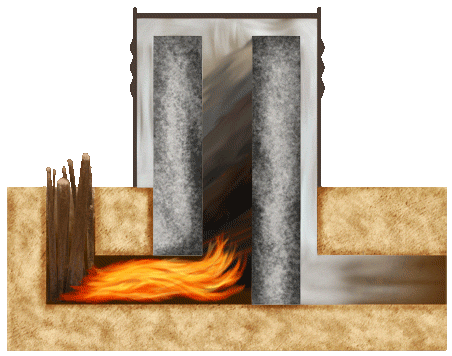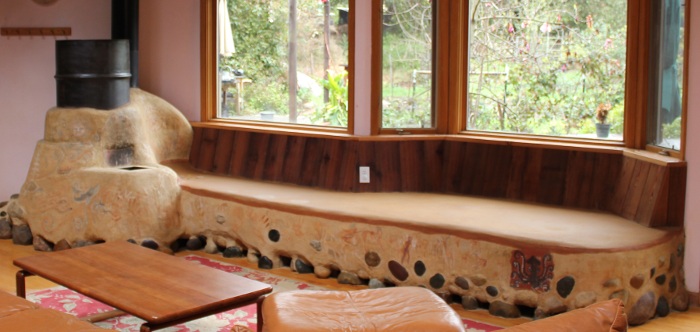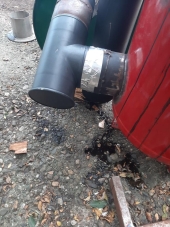Here is a little article I wrote up over at
my blog about the awesomeness of rocket mass heaters. I'll share it here for permies to enjoy.
Here we are in the depths of winter and it is cold. How would you like to heat your home with one tenth the wood you would normally burn in your conventional wood stove? How would you like to have the heat from your fire last through the night into the next day so you don't have to wake up to a freezing house to start the fire again? How would you like a heated couch to lounge on during those super cold nights? How about burning so cleanly that only steam and CO2 are produced? Does all this sound like a sweet deal? Welcome to the world of rocket mass heaters, where you burn less wood, generate more heat, and keep that heat for days!
How is this all possible you ask? As it goes with permaculture, it all comes down to excellent design. This stove is designed in such a way that only the end of the wood is burning and the fire is directed to an insulated chimney (heat riser) where it can get even hotter, thus burning more completely and cleaner. The insulated heat riser is capped by a barrel, but leaving enough space for the exhaust to pass by and cool as it falls down the side of the barrel. This exhaust is now routed through ducting encapsulated in a mass. As the exhaust travels through the ducting in the mass, it transfers its heat energy to the mass, warming the mass. Finally the exhaust is sent out the chimney after having transferred most of it's heat into the room.
The secret is in the heat riser. Here is where the magic happens. Instead of trying to capture the heat directly from burning wood, the rocket mass heater channels that fire to a space where it can get even hotter; the insulated heat riser. Here the fire gets crazy hot because it is in an insulated space. This increase in heat leads to the smoke from the initial burning of wood to also burn, making for less smoke and adding to the fuel the fire has available to burn. This is basically creating a chimney fire all the time. Nearly all the available combustible material is burned in this insulated heat riser. As the fire reaches the top of the heat riser, it comes in contact with the encapsulating barrel and rapidly cools as the barrel sheds heat into the room where the stove is located. The remaining gasses, mostly CO2 and steam, fall down the sides of the barrel as they cool and are pumped to the ducting running through the mass by the convective current produced by the crazy hot burn in the heat riser sucking air in through the wood feed and forcing the exhaust gasses through the ducting to heat the mass.
Below is an excellent illustration showing the vertical wood feed, horizontal burn tunnel, insulated heat riser, barrel capping, and gasses being pushed through the system.

Let's examine the sideways burning fire. At first it doesn't seem like this is possible, but upon closer inspection we can see how it works. Again, it's all about the heat riser. As warm air rises up through the heat riser, fresh air must replace the air that is rising and the only place for this air to come from, is through the wood feed. So the hotter the fire burns, the more fresh air it needs and the harder it sucks that air through the wood feed opening. The fire is then pulled along sideways through the burn tunnel with the suction created by the hot air rising in the heat riser, making a fire that burns sideways. This suction also prevents smoke from coming up through the wood feed hole into the house.
Why make the wood feed vertical? A couple things happen when the wood feed is designed vertically. First of all, the wood self feeds. As the fire burns the ends of the wood away, the wood falls down into the fire with the help of gravity. If the wood feed were horizontal you would have to continuously push the wood into the fire to keep it burning. So you can fill up the wood feed with wood and be sure it will all burn without your having to help it along. Secondly, with a vertical wood feed, you have only the ends of the wood burning and fresh, warm air being sucked in past the yet-to-be-burned wood. This allows for a better burn. The wood is warmed prior to reaching the point where the fire is, instead of having cold wood sitting on top of the actual fire and energy from the fire being used to warm the wood. The energy from the fire is going towards burning the gasses released by the wood as it ignites, which are being sucked through the burn tunnel and up the heat riser by the convective current.
So far so good? The wood is standing vertically in the wood feed, while burning just at the tip by a fire that is burning sideways, which is being sucked into an insulated heat riser, by a convective current, where temperatures get crazy hot and all the smoke burns. As the heat and exhaust exit the insulated heat riser, they are captured by a barrel which caps this system. The barrel serves two functions. Firstly it captures the exhaust gasses being pumped out of the heat riser and channels them to the exhaust duct. Secondly, it acts as a heat sink allowing the captured gasses to cool as they exit the heat riser and fall down the inside of the barrel to the exhaust duct. The barrel becomes hot and acts like your conventional wood stove by providing immediate heat to the room. You can also cook, or heat water on the top of the barrel if you so choose.
Now we get to the next awesome part about the rocket mass heater; the mass. Here is where all that excess heat energy which wasn't dispersed by the barrel gets stored. This is the part that stays warm for days after the fire has gone out!
The exhaust that is captured by the barrel is pumped, using the convective current (created by the heat riser) to push now, through thirty plus feet of ducting that is encased in a solid mass. The remaining heat energy in this exhaust is transferred to the mass, where it is stored for an extended period of time, warming your butt long after the fire goes out. In conventional wood stoves, all this extra heat energy is used to pump the exhaust straight out the chimney and is lost to the outside. Conventional stoves have exhaust exit temperatures around 600 degrees F, where the exhaust exit temperatures on the rocket mass heater are more like 150 degrees F. A massive amount of heat energy being captured and stored there for later use.
Here is a picture of a beautifully finished rocket mass heater. You can see the large mass bench where the exhaust runs all the way to one end and all the way back before exiting through the chimney behind the barrel.

Now that is one fine looking piece of art of a rocket mass heater if I ever did see one!
On top of that massive decrease in exhaust temperature, there is an even greater reduction in dirty smoke released through the chimney. With a conventional wood stove, all the burning is done in the steel box which directly radiates the heat into the room, making it so the temperatures reached when burning are not hot enough to burn all the smoke. Much of this heat is also needed to pump the smoke out the chimney. Under ideal, super hot burning conditions, with really dry wood, the wood stove would do fairly well and produce relatively little smoke, but that's not how it works in real life. Most people don't run their wood stoves at maximum temperature and don't have super dry wood. Usually semi wet wood is burned with the damper closed to make the fire last through the night and keep the house warm. When burning in this manner, huge amounts of unburned smoke are sent up through the chimney creating unsafe creosote build up on it's way to polluting the out doors.
But with the rocket mass heater, this problem doesn't exist. The rocket mass heater only burns at top speed, which is super hot because of the insulated heat riser, and this super hot burn causes the smoke, which would go up the chimney in a wood stove, to burn and turn to CO2 and steam. This burn is so clean that it produces one one thousandth (1/1000) the amount of smoke of a standard wood stove! That's so clean that people are reporting using these in cities where wood stoves are banned because of the smoke they generate, but the rocket mass heater exhaust just looks like a dryer vent and no one asks any questions. Amazing!
How did rocket mass heaters come about and why haven't I heard of them if they are so awesome you ask?
Let's start with how they came about. Nothing about these wood burning stoves is new technology, only the way the parts have been arranged is new.
Heating a mass to store that heat for extended use has been a documented practice for a long time now. Some bread ovens in the middle ages, for example, were enclosed masses, warmed by an initial fire, with the heat stored in the mass after the fire went out, to actually cook the bread. Masonry heaters are also a good example of storing heat in a mass to keep a room/house warm after the fire has gone out.
Channelling fire through a heat riser is also old technology, used in such as examples as the pit stove. Here the people would dig a pit and dig a tunnel over to the bottom of the pit to feed the wood through and make the fire rise up through the pit. Positioned above the pit is the hot cooking spot. A fire channelled up through a concentrated space burns hotter.
The actual rocket stove J-tube design, which is the combustion unit part,where the wood feed and burn tunnel make up the small vertical and horizontal parts of the "J" and the heat riser the longer vertical part, seems to have been invented mostly by Ianto Evans along, with a group he was working with to provide efficient cook stoves to people in Africa. The original concept of concentrating a fire through a heat riser to make it burn hotter, was taken and innovated upon to make for even better combustion and ease of use. This is the most critical part of the rocket mass heater. It makes the whole thing sing. It seems that it was Ianto again who went and added the barrel cover, over the heat riser, to capture the exhaust gasses and heat and direct them through a mass to store heat for future use.
So the rocket mass heater has only been built for about the last 35 years or so. Being a technology that doesn't make someone a lot of money, it hasn't been heavily marketed. Factors along these lines would probably be why you've never heard of rocket mass heaters, but it's all changing now. The word is really getting out there and further innovations are happening all the time, thanks to folks like Ernie and Erica Wisner, Paul Wheaton, and all the other folks out there on permies.com. Go check out their sites for tonnes more information on these super amazing wood burning stoves.

Doesn't that look cozy!

 2
2





























 1
1
































